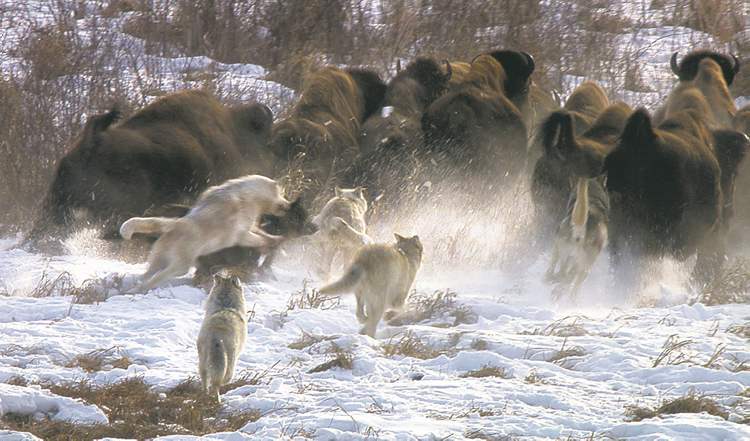Stunning footage of wolf hunt reveals creatures’ cunning
Advertisement
Read this article for free:
or
Already have an account? Log in here »
To continue reading, please subscribe:
Monthly Digital Subscription
$1 per week for 24 weeks*
- Enjoy unlimited reading on winnipegfreepress.com
- Read the E-Edition, our digital replica newspaper
- Access News Break, our award-winning app
- Play interactive puzzles
*Billed as $4.00 plus GST every four weeks. After 24 weeks, price increases to the regular rate of $19.00 plus GST every four weeks. Offer available to new and qualified returning subscribers only. Cancel any time.
Monthly Digital Subscription
$4.75/week*
- Enjoy unlimited reading on winnipegfreepress.com
- Read the E-Edition, our digital replica newspaper
- Access News Break, our award-winning app
- Play interactive puzzles
*Billed as $19 plus GST every four weeks. Cancel any time.
To continue reading, please subscribe:
Add Free Press access to your Brandon Sun subscription for only an additional
$1 for the first 4 weeks*
*Your next subscription payment will increase by $1.00 and you will be charged $16.99 plus GST for four weeks. After four weeks, your payment will increase to $23.99 plus GST every four weeks.
Read unlimited articles for free today:
or
Already have an account? Log in here »
Hey there, time traveller!
This article was published 13/02/2013 (4626 days ago), so information in it may no longer be current.
For regular viewers of PBS’s Nature, up-close encounters with the brutality of life in the animal kingdom are nothing new.
Some creatures are predators; some are prey. The survival of one group depends on the failure of the other’s skills and instincts, and the manner in which outcomes are determined is bloody and abrupt.
Nature, one might argue, is the original reality-TV series, and the violence that is inherent to its storylines is made palatable by the fact it all falls within a cycle-of-life context.

There’s a particular resonance for Canadian viewers in this week’s instalment of Nature, Cold Warriors: Wolves and Buffalo. It’s an interesting, beautifully rendered examination of the relationship between two of this country’s signature wildlife species, filmed in Canada’s largest national park.
Cold Warriors follows nature-documentary filmmaker Jeff Turner through a year-long effort to record the movements of one particular wolf pack in Wood Buffalo National Park, which straddles the border between northeastern Alberta and the Northwest Territories.
The film opens in the harsh cold of winter, with Turner following a group he calls Delta Pack — a tightly knit unit of wolves, usually about eight, led by a large alpha male — as it ranges more than 50 kilometres a day in search of food.
Aided by a helicopter-mounted camera that allows him to trace the pack’s movements from above, Turner captures stunning (and sometimes shocking) footage of the wolves as they locate a herd of buffalo and employ shrewd teamwork to force the much-larger animals out of their defensive cluster and into a full-out run across the tundra that exposes the weak and vulnerable to the tireless hunters.
The outcome is predictable; what’s fascinating is the precision and shrewd strategy employed by the predatory animals. Turner is absolutely correct in his assertion that capturing footage of the full wolf-pack hunt would be impossible without the aerial views the chopper provides.
With the winter hunt recorded, the filmmaker makes plans to return in spring to see if he can reconnect with the wolves in time for the birth of their spring litter.
He does, and we’re offered a much-changed landscape and a very different set of circumstances. The presence of newborn pups puts added pressure on the adult wolves to find food. The buffalo have new offspring, as well — prime targets for the carnivores, but the herd is much more mobile on solid ground than in deep snow, and the buffalo parents are fiercely protective of their calves.
“In these situations, it’s hard to know who to hope for,” Turner says over footage of the wolves’ pursuit of a mother and calf separated from the herd, “this mother buffalo and her injured calf, or the female wolf with hungry pups at the den.”
It is a heart-wrenching sequence.
Turner returns to Wood Buffalo in September to find that Delta Pack’s numbers have increased — the return of several wolves that had wandered away for a time has brought the number to 17, which makes the strategy of the hunt both more complex and more effective.
All in all, it’s a compelling collection of footage. If there’s a weakness to Turner’s effort, it’s the short shrift he gives to the impact the continuing development of Alberta’s oil sands might have on Wood Buffalo and its inhabitants. He spends a scant few moments near the film’s end considering the smog- and toxin-spewing mega-projects, which lie directly upstream of the animals’ habitat.
“How will this affect the wolves and buffalo? No one knows for sure,” he comments. But surely, the undeniable threat to the park’s delicate ecosystem deserves the pursuit of a few answers.
It’s the only incomplete element — but a large, looming one — in an otherwise well-told story.
brad.oswald@freepress.mb.ca Twitter: @BradOswald
TV REVIEW
Cold Warriors: Wolves and Buffalo
Filmed and narrated by Jeff Turner
Tonight at 7
PBS
31Ñ2 stars out of 5

Our newsroom depends on a growing audience of readers to power our journalism. If you are not a paid reader, please consider becoming a subscriber.
Our newsroom depends on its audience of readers to power our journalism. Thank you for your support.

